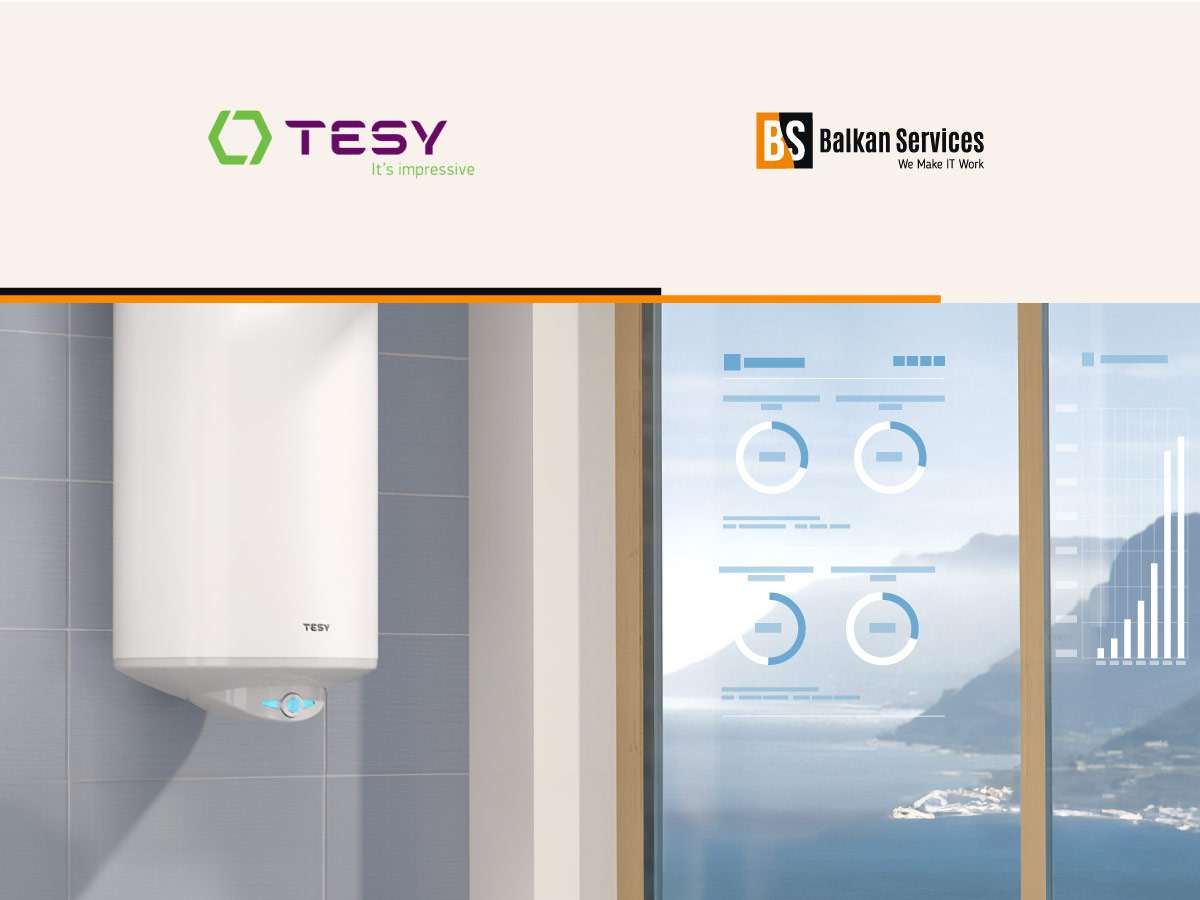Contact information.
-
Address"Ekzarh Yosif" street, 31, 1000 Sofia, Bulgaria
-
Phone:+359 2 980 95 99
-
Websitewww.balkanservices.com

In the ever-evolving world of analytics tools, and Business Intelligence (BI) in particular, progress is often about recognizing change as a driving force. With the rise of technology and the need to modernize, many organizations are considering the challenging but vital process of migrating from one BI tool to a next-generation one.
In the following lines, we’ll tell you about how one of the world’s most recognizable Bulgarian companies evolved from a satisfied QlikView user to a successful Qlik Sense user.
TESY, the leading Bulgarian and European manufacturer of electric water heaters, indirect-fired water heaters, and home heaters, has four factories located in Shumen and Smiadovo. In 2023, the company started construction of a new modern plant for thermodynamic water heaters, which is expected to be operational in 2024. The company has its own research and training center.
The company’s products feature an operating mode that reduces electricity costs. The solutions that TESY is using to create even more convenience for its users are a mobile app to control the heaters and also an augmented reality app.
Thanks to its innovative approach to the market and products and a dynamic team of highly motivated specialists, TESY is currently selling its products in 65 countries on 4 continents, with sales revenues growing by double digits every year. The company started its international expansion in 1997 to reach today the top 3 manufacturers in Europe in its industry.
As an innovative, export-oriented company, TESY relies on “smart” technology in its daily operations. A decade ago, the company launched its state-of-the-art business analytics software QlikView.
Before, when it was not possible to process a large amount of information in a short time, it certainly made it difficult for us, on the one hand, because of the time, on the other hand, because of the complexity of the calculations, and of course, with such a long process and processing a lot of data, the risk of making mistakes was high. The introduction of Qlik in the company certainly led to a drastic, qualitative “leap” in the daily work of colleagues at that time, because these tools allow extremely fast generation of different analyses, on different cross-sections, at different levels of aggregation, and every day you have up-to-date information on what is happening” says Georgi Georgiev, Director of Information Systems at TESY.
The QlikView BI system was implemented by Balkan Services consultants – since then the successful cooperation between the two companies dates back.
The catalyst for switching from the QlikView BI software to the newer and more modern Qlik Sense BI solution was the decision of Balkan Services’ long-time partner and business analytics software vendor, Qlik, to announce a new attractive program called the “Analytics Modernization Program”.
Its main purpose is to enable QlikView users to upgrade their analytics capabilities by introducing the next-generation Qlik Sense BI solution without additional license costs and allowing parallel use of both BI systems.
The main reason for our decision was the end of the QlikView lifecycle,” explains TESY’s Georgi Georgiev.
According to his observations, the transition to Qlik Sense is not accompanied by any serious difficulties for users and happens naturally.
Qlik’s newer product better fits TESY’s vision of an innovative company,” comments Kristina Krustanova, Head of BI at Balkan Services.
Read more: Business Intelligence software- what, for whom and why
The project started with preliminary meetings with key users of the system on the TESY side, during which the current reporting in QlikView was reviewed and what could be done to upgrade the reports and reports in Qlik Sense.
Next, a new task was defined – order fulfillment management (specifically: are orders placed late and by how much time). The business process is analyzed from receiving an order from a TESY customer to creating a delivery schedule according to the stock in the warehouse to requesting dispatch and shipment, to issuing an invoice once the customer has received their order.
In addition to order tracking, this additional analysis also enriched the picture of actual sales by adding what has already been ordered but is still in the process of delivery to what has been invoiced. Finally, the quantities forecasted to be sold are added from a separate forecasting module. The overall picture is thus presented in the so-called “Execution Tracking Report”.
This was a very essential part of the project, as at that time this additional data was not analyzed in any way in QlikView,” says Kristina Krustanova, while Ina Kehayova adds that in this project TESY for the first time made a direct connection between the BI software and data from the SAP system.
The experience of Balkan Services consultants shows that among the most common challenges for companies using high-end ERP solutions is precisely the implementation of reporting since data analysis is not the main function of business management systems.
Read more: Maximizing the benefits of ERP – how do the big companies do it
In the new BI software, up-to-date versions of the company’s business data are available. This functionality is important because TESY develops various forecasts and plans in their work.
The business analytics system makes a comparison between actual data and TESY’s sales plans. In this way, the company can assess how accurate its forecasts and plans are, and this allows it to react promptly,” explains the experts from the Balkan Services team.
In practice, the BI system allows the TESY team to see the level of execution of each order – from its receipt, through its shipment to the receipt of payment. In Qlik Sense there are several separate groups at the analytics level – for the company, for customers (by channel, country, and region), and for by-products (code and product name).
All reports in the entire project can be recalculated in euros and euros with just one click. They can be presented as consolidated or unconsolidated sales, which is important for sales by country.
One of the latest developments from the Balkan Services consultants at Qlik Sense is related to the so-called “ABC” analysis.
Colleagues quite intensively started using this functionality right away. It is by monitoring the sales levels and sales volumes of specific products that they assess which product falls into which category and plan its lifecycle,” says Georgi Georgiev from TESY.
The way data is extracted and processed in both systems is similar, but the visualizations are quite different.
TESY has experience with QlikView, but the Qlik Sense software has a different interface – buttons, new colors, and different organization of selections.
To ease the transition from one software to this new generation, we created a new appendix in the BI system that describes the main functionalities of Qlik Sense. We have also recorded a series of videos explaining the different ways of working with Qlik Sense. In the case of TESY, they are in English, as the users of the system are from other countries, not only Bulgaria“, says Ina Kehayova.
Our team is here to listen carefully and offer the right solution for you.

In the new BI software daily, TESY monitors its sales and compares them with its plans. On the other hand, the financial situation of the company is analyzed in terms of the turnover of materials, receivables, and payables.
Qlik Sense is the main source of information on actual sales and comparison with the plan for all colleagues in the sales division depending on the regions they are responsible for,” explains Georgy Georgiev.
The cash flow and material turnover applications have also been upgraded. These have been developed on behalf of the finance division and in particular the company’s CFO.
Several assignments are to be developed that are in a completely different area – manufacturing,” predicts the director of information systems at TESY.
Read more: What is the price of a Business intelligence software [Part 1]
The project has been broken down into different stages and several teams are involved depending on the data that is transferred, processed, and added.
The transfer and upgrade team from Balkan Services included colleagues from the expert support team who were familiar with TESY’s current applications and data in QlikView. From this perspective, we had the necessary knowledge and understanding of TESY’s business and the initial analysis focused on what we could change and how we could build on their analytics in Qlik Sense,” says Kristina Krastanova.
The communication between the TESY team and our team is at a very high level.
The TESY team has been responsive. Regular meetings were held all the time to monitor the progress of the project and discuss current issues. The bonding was at a very high level and we worked as a team to achieve the end goal,” recalls Kristina Krastanova.
Georgi Georgiev of TESY’s impressions of the collaboration are that the Balkan Services team knows the project in enough detail to guarantee its good outcome.
The two teams worked well together from before and all the project participants went deep enough into the analysis and finding an appropriate solution. We defined the final solution of what we needed, and then looked at the data together on how to generate that outcome. In many of the situations, the Balkan Services team was quicker than we were, which made it much easier. This shows that the people working on the project know it in enough detail, which also guarantees the best result,” he emphasizes
Ina Kehayova adds that the project managers from the two companies also worked very well together.
They freed us from various, purely communication moments so that we could do our work much more expeditiously,” she explains.
The successful completion of the project was due to the competence of the people who worked on it, as well as TESY’s determination to make it happen and the support of management.
In any project, it is like this, if people do not have the conviction that it has to be achieved and the support of management is lacking, such a project would be difficult. In our case, these two factors were present, as at TESY we have adopted Qlik as our analytics and business intelligence tool,” says Georgi Georgiev in summary.
At Balkan Services we have expert knowledge of business, technology and legislation, and we speak all three languages. We will listen carefully and advise you on choosing the right business system for your needs.
Balkan Services has been implementing business software solutions since 2006 and has completed more than 720 projects, of which over 440 are in the area of BI systems. We follow a proven implementation methodology with clear steps and know-how on best practices.